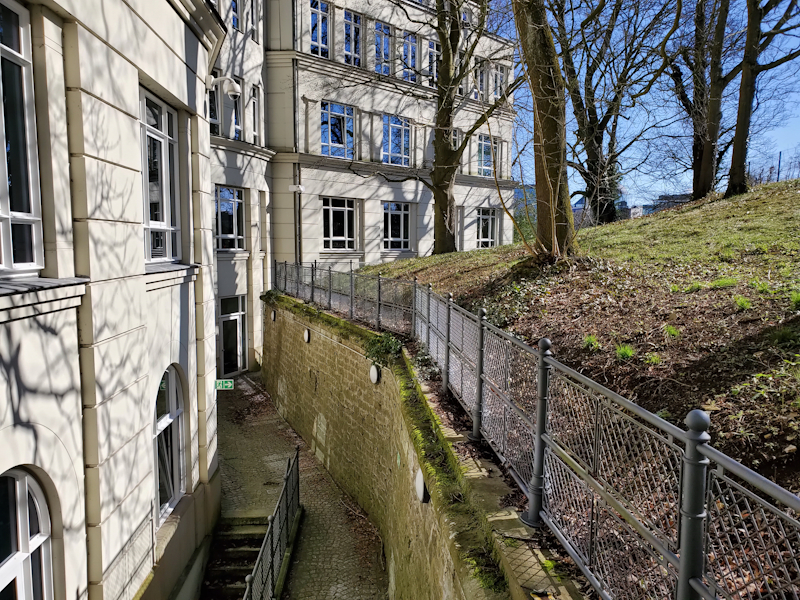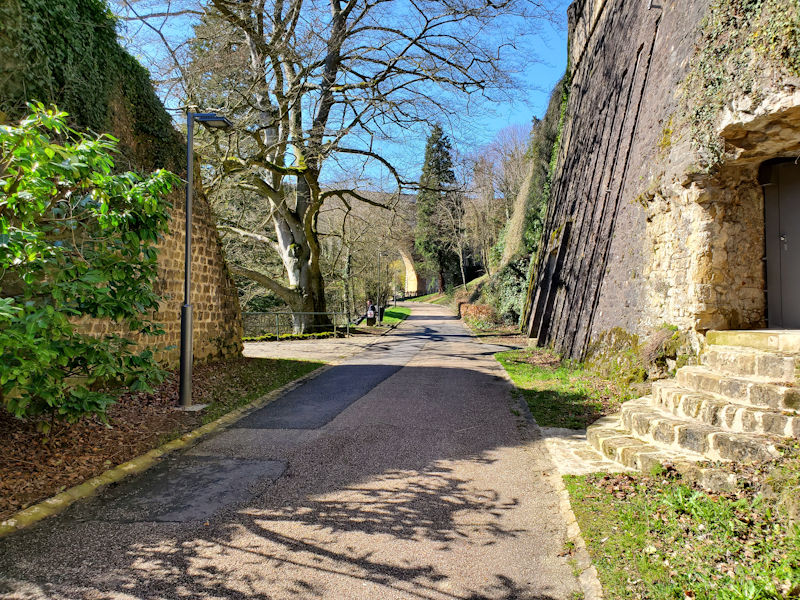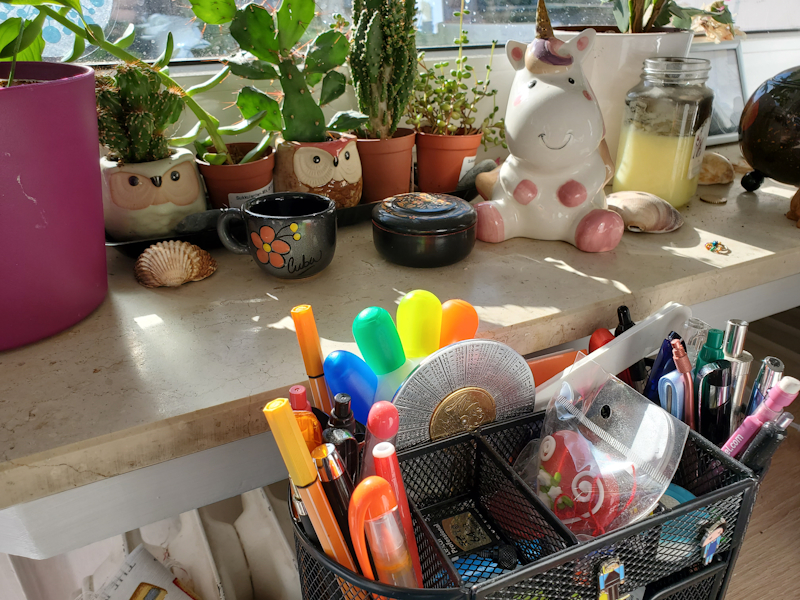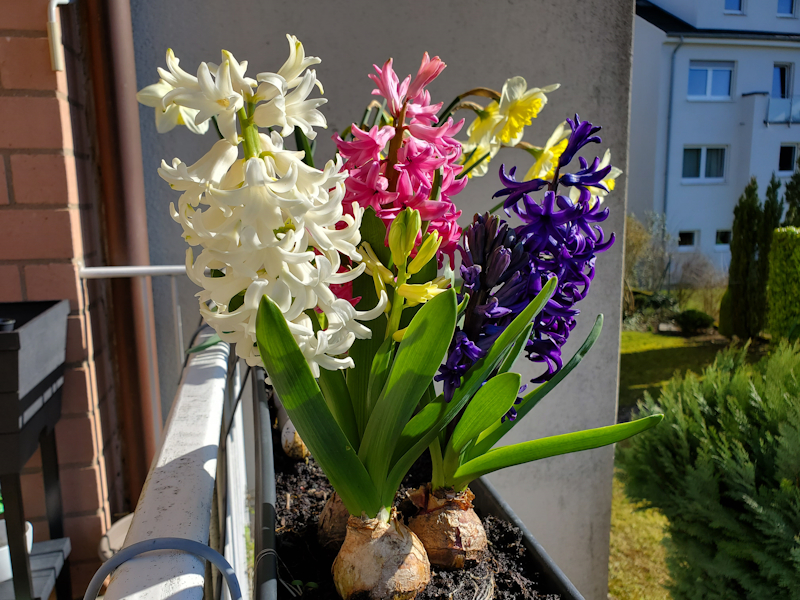The Samsung Galaxy S10+ Snapdragon & Exynos Review: Almost Perfect, Yet So Flawed
by Andrei Frumusanu on March 29, 2019 9:00 AM ESTDaylight Evaluation: Dynamic Range For Snapdragon

[ Galaxy S10+ Snapdragon ] - [ Galaxy S10+ Exynos ]
[ Galaxy Note9 (E) ] - [ Galaxy S9+ (S) ] - [ Galaxy S8 ]
[ iPhone XS ] - [ iPhone X ] - [ LG V40 ] - [ OnePlus 6T ]
[ Pixel 3 ] - [ View20 ] - [ Mate 20Pro ]
This shot is massively challenging for HDR algorithms as there’s very high natural contrast between light and dark areas of the scene with very fine detail throughout the whole frame. Both phones have nearly the same exposure but the Snapdragon is able to bring out brighter shadows with more detail. The Snapdragon does better at keeping some highlights in check in some parts of the scene while the Exynos does better in some other parts, overall I’d say it’s about even in this regard.
Both S10 phones actually see massive improvements in dynamic range and colour accuracy compared to prior Galaxy phones. The V40 is the only other phone that comes close to accurately reproducing the scene, however The S10 remains ahead in dynamic range and contrast while maintaining shadow detail.
On the wide angle, the Exynos does a horrible result in the HDR processing. In the histrogram the top 15% of levels are nearly non-existing and this is why the image seems to flat, especially a lot of the greens are compressed far too much resulting in unnatural and flat textures on leaves and on the moss. We can also add this shot to the list of wide-angle results where the Snapdragon’s optics seem much better.
The Mate 20 Pro is a contender for detail in this shot, but loses out in colours and dynamic range to the S10.
 [ Galaxy S10+ Snapdragon ] - [ Galaxy S10+ Exynos ]
[ Galaxy S10+ Snapdragon ] - [ Galaxy S10+ Exynos ]
[ Galaxy Note9 (E) ] - [ Galaxy S9+ (S) ] - [ Galaxy S8 ]
[ iPhone XS ] - [ iPhone X ] - [ LG V40 ] - [ OnePlus 6T ]
[ Pixel 3 ] - [ View20 ] - [ Mate 20Pro ]
The next shot the overall composition is similar between the phones. The Snapdragon just has a ton more detail as we can see grass, moss and cracks in the brick wall that are much better defined than on the Exynos.
The S10s lead the pack in terms of overall picture quality as they’re spot on with the colour balance and dynamic range of the shot. The XS would have been a contender but its colour balance is off and the Mate 20 Pro is lacking a bit in contrast.
Big differences in the wide angle again with the Snapdragon having better HDR and detail retention throughout.
 [ Galaxy S10+ Snapdragon ] - [ Galaxy S10+ Exynos ]
[ Galaxy S10+ Snapdragon ] - [ Galaxy S10+ Exynos ]
[ Galaxy Note9 (E) ] - [ Galaxy S9+ (S) ] - [ Galaxy S8 ]
[ iPhone XS ] - [ iPhone X ] - [ LG V40 ] - [ OnePlus 6T ]
[ Pixel 3 ] - [ View20 ] - [ Mate 20Pro ]
The main camera module here again goes to the Snapdragon although it’s almost overblowing the highlights. The Exynos is afraid to use the last 10% of levels however in such a sunlit scene this would have been a very accurate representation. The saturation difference in the foliage is also jarring, the Exynos is a lot more flat and dull than the Snapdragon.
On the wide angle lens, if I would have to summarise the Snapdragon and Exynos differences of the S10 then I would show them these two shots as they couldn’t be any more different. It’s kind of absurd as one would think I’m comparing last year’s phone against the newest generation, that’s how better the Snapdragon wide angle result is. The V40 competes composition wise but details are washed out.
 [ Galaxy S10+ Snapdragon ] - [ Galaxy S10+ Exynos ]
[ Galaxy S10+ Snapdragon ] - [ Galaxy S10+ Exynos ]
[ Galaxy Note9 (E) ] - [ Galaxy S9+ (S) ] - [ Galaxy S8 ]
[ iPhone XS ] - [ iPhone X ] - [ LG V40 ] - [ OnePlus 6T ]
[ Pixel 3 ] - [ View20 ] - [ Mate 20Pro ]
In terms of detail in the shop window here the Snapdragon has very slight advantages. It also has more saturated colours, however it doesn’t exaggerate them.

[ Galaxy S10+ Snapdragon ] - [ Galaxy S10+ Exynos ]
[ Galaxy Note9 (E) ] - [ Galaxy S9+ (S) ] - [ Galaxy S8 ]
[ iPhone XS ] - [ iPhone X ] - [ LG V40 ] - [ OnePlus 6T ]
[ Pixel 3 ] - [ View20 ] - [ Mate 20Pro ]
 [ Galaxy S10+ Snapdragon ] - [ Galaxy S10+ Exynos ]
[ Galaxy S10+ Snapdragon ] - [ Galaxy S10+ Exynos ]
[ Galaxy Note9 (E) ] - [ Galaxy S9+ (S) ] - [ Galaxy S8 ]
[ iPhone XS ] - [ iPhone X ] - [ LG V40 ] - [ OnePlus 6T ]
[ Pixel 3 ] - [ View20 ] - [ Mate 20Pro ]
The flower shot is more of a test of the sensor’s light capture ability as flowers reflect light in a very wide spectrum. There’s some slight differences in the S10 but nothing to really come to any conclusion.
Daylight Camera Conclusion
Overall, the camera evaluation of the Galaxy S10 was extremely revealing this generation. I would have not expected such big differences between the Exynos and Snapdragon units and this really exposes an issue which I think hadn’t been brought up before in such detail.
Clearly the HDR processing on the Snapdragon chip is superior, but the Snapdragon unit is also to resolve better details and also produces more (correctly) colourful images, whereas the Exynos can appear washed out an dull.
That being said, both units showcase huge improvements in their dynamic range capture ability which makes big jumps compared to past devices. One aspect of the Galaxy S10s that I saw was essentially flawless was the colour balance. In all the scenes I’ve shot in this evaluation I didn’t see one shot of the S10s where it was off in terms of colour reproduction (besides the Exynos’ sometimes dull saturations). In terms of shooting consistency as well, although both S10s differed between each other, in terms of consecutive shots this was probably Samsung’s best camera experience yet.
Exposure in particular is absolutely spot on. Many of the scenes were shot in on a day with no clouds at all with a very bright sun and here the S10 actually took advantage of the higher levels in the produces shots which some other phones don’t do. The Pixel 3 for example is a prime case of this as the last 10% of levels are almost never used which results in missing highlights in almost all shots, resulting in a dark image that just doesn’t make sense given the environment of the scene.
I really love these aspects about the Galaxy S10 camera in daylight shots as it produces just better shots.
The wide angle module is a fantastic addition to the phone. Previously only LG was able to sport such a feature, and the Mate 20’s from Huawei were the first to follow LG in this regard. I had mentioned that the Mate 20 Pro’s wide angle was excellent, however the only comparison point was LG’s own, which unfortunately suffers from processing issues. The S10’s wide angle beats both in many scenarios. It’s also on the wide angle where we see the most drastic differences between the two tested S10 models. One thing that I think is a hardware issue on the Exynos unit I’ve tested is the camera lens of the wide angle module as it’s showing very blurred details in off-centre details. Because the camera module is fixed focus, I don’t think this is something that will be fixed in any update.










229 Comments
View All Comments
luca.costantino - Friday, March 29, 2019 - link
Way too much bloatware on Samsung products for my taste. I would never consider buying a phone from them.shabby - Friday, March 29, 2019 - link
Are you offended or something? That's the dumbest comment I ever read, I just sold an s9 and wiped it, the buyer said I thought it would have more bloatware but it doesn't.liteon163 - Friday, March 29, 2019 - link
No need to be so harsh simply because you disagree with someone's opinion, dude. Don't be a jerk (that's not an opinion, that's a FACT proven by your initial reply).close - Sunday, March 31, 2019 - link
Samsung has their own equivalent of every single piece of software that comes with Android and you already didn't want in your phone. @shabby just wanted to tell us he knows how to follow a decrapify tutorial. The phone is still crappy software-wise but after putting in a lot of effort you can make it marginally less crappy. Yay?Vermite - Sunday, May 19, 2019 - link
You're an idiot. Yay?s.yu - Sunday, March 31, 2019 - link
There are smarter opinions and stupider opinions.goatfajitas - Friday, March 29, 2019 - link
Yes, it does have alot of bloat.mazook - Friday, March 29, 2019 - link
Dude, the ROM is about 4 GIGS.Think there's just a BIT of bloat in there?
Samus - Sunday, March 31, 2019 - link
I figured Android users are just used to bloat at this point. I’d you want a clean optimized mobile experience you either buy a Google phone, install a 3rd party ROM, or just buy an iPhone.notashill - Monday, April 1, 2019 - link
The "bloatware free" Android One ROMs are like 12 gigs though they do keep 2 entire copies of the system partition for the seamless update feature. Very annoying especially considering how many Android One devices have 32GB storage.